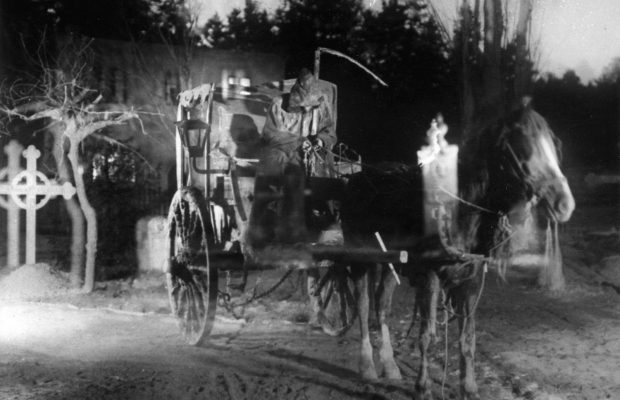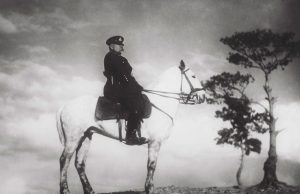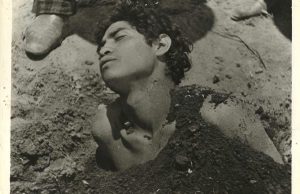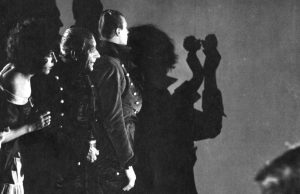The Phantom Chariot (1920)

Toronto Film Society presented The Phantom Chariot (1920) on Monday, January 16, 1961 as part of the Season 13 Monday Evening Silent Film Series, Programme 3.
Etoile de Mer (France 1928). Directed by Man Ray. The director as a virtuoso of the camera. By using difforming, prismatic lenses, Ray achieves an effect like that of neo-impressionist painting, a sort of cinematic pointillism. Kiki, the famous Paris model of the Twenties, plays the leading role.
In the Street (USA 1952). Directed and photographed by Helen Levitt, Janice Loeb and James Agee. Not originally intended to be a film, this grew out of sporadic street shooting by the above three, all of whom had had a part in the making of The Quiet One and who subsequently wanted to experiment with the basic art and craft of the film medium, photography itself. Using angle viewers to conceal from their subjects that they were being photographed, they sought what the camera could reveal of random behaviour in the neighbourhood of 105th Street, East Side New York. As their footage grew, they found in it an emerging pattern which could provide, in the form of a film, an “image of human existence”. The image thus created corresponds to and extends the “exact instant” in still photography. The camera enters the stream of life, searching juxtapositions, emphasize, besides significance, the vast array of accident and incident in the midst of which they occur. In this classic sense In the Street is an “endless film”, as well as an advance inquiry into the nature of motion picture photography, and a unique revelation of the human countenance unmasked.
The Scandinavian Cinema
The Phantom Chariot (Sweden 1920). Production: Svensk Filmindustri. Direction and Scenario: Victor Sjöström; from the novel by Selma Lagerlof. Photography: Julius Jaenzon. Design: Alexander Bako. Cast: Victor Sjöström, Astrid Holm Tore Svennberg, Hilda Borgstrom.
In an extensive article on the life and career of Victor Sjöström (Films in Review, May and June-July, 1960), Charles Turner refers to this film as “his masterpiece, both as actor and director”. It was the first film to be made in the newly built Svensk Filmindustri studios (which now produce Bergman’s films). “Even before the building was finished”, Sjöström wrote 25 years later, “I shot the first scenes, the New Year’s scenes in the churchyard. Now that we had so much good space we could afford to build both the church and the churchyard in the studio”. The Phantom Chariot was also variously known as Korkarlen, at the Stoke of Midnight, and Thy Soul Shall Bear Witness. The story has been remade in sound versions both in Sweden and in France (by Julien Duvivier as La Charette Fantome).
Comment by Critics and Film Historians
Bardeche and Brasillach: ” Sjöström’s most famous film–this story of the redemption of David Holm, a drunkard beloved by a pious young girl, was not properly understood in the Latin Countries, and many of the Salvationist scenes were cut out, such as the one in which the girl persuades Holm’s wife to take him back, thus bringing tragedy to them and their children. There was more fatalism and more intelligence in the piece than the cinemas could accept readily. What drew both the general public and the highbrows to the film, and made it one of the most famous of all films–as famous as The Gold Rush, Caligari, and Potemkin, were the scenes in which David meets his old boon companion George, who had died on New Year’s Eve, and so becomes driver of the ghostly cart that comes to collect the souls of sinners. This supernatural figure, who was the focal point of the human story of Selma Lagerlof, also dominated the film to such a point as to obscure its other qualities. The film seems rather old-fashioned to us today, partly because of its somewhat excessive moralizing, and partly too because technically it was at the time so very important and so new. It seemed literally dazzling then; now it seems almost obvious. It was the first time that the supernatural world had been brought to the screen with anything like so much talent, but Sjöström had tried to express the supernatural and make thought tangible by means of the rather tedious use of double exposure. Later on it was to be realized that this method of showing one rather dim image over another fairly distinct image, in order to convey a hidden thought or spiritual truth, is an extremely material and physical device, and an erroneous one. The moment it is translated into the perceptible, the invisible is invisible no longer, but just a clever photographic trick. Nevertheless, some of the scenes in The Phantom Chariot are of remarkable brilliance and rare emotional power. Sjöström possessed a marked ability to visualize and to compose, and he loved nature with intense passion. Therefore, in the “vision” scenes, one enjoys most the wide empty road on which, as in a dream, the strange equipage of the death driver suddenly looms through the fog and the rain. The road, the sea, the cemetery carry us to the realms of poetry and of piety as powerfully as when the film was made. At the same time the grave bearing of the participants makes us realize that the film can really at times attain artistic perfection by the truths it reveals through the human face and the human body.”
Rune Waldektranz in Swedish Cinema: “Here Sjöström arrived at a synthesis of the naturalism of his early films and the charming lyricism of his Ingmar trilogy, a romantic realism perfectly suited to Selma Lagerlof’s story of the struggle between good and evil in human nature. Assisted brilliantly by his cameraman, he transformed an incredible legend into a stirring motion picture; in the leading role, he himself created a portrait that stands practically alone in its time for its naturalness and lack of theatrical exaggeration.”
Forsyth Hard in Scandinavian Film: “This story would have made a moving film whatever its treatment; it was made outstanding by the place given to the supernatural in the expression of the theme. There had been a hint of this technique in Stiller’s Herr Arne’s Treasure, but here it was elaborated until it became an integral part of the film. Some of the scenes of the ghostly carriage moving along a shadowed road had a strange beauty which has never been equalled in cinema. From the beginning the Swedish cameramen had served the directors well, bringing a flow of sensitively evocative pictures to the screen. Julius Jaenzon’s work in The Phantom Chariot helped both to enrich the director’s expression of his theme and to bring international recognition to the technical achievement of the Swedish films. Sjöström’s performances were seldom less than powerful, but his acting in The Phantom Chariot showed a studied restraint. The exaggerated gestures of some of the early films had gone, but the intensity of feeling was still there.”
In Memoriam: Victor Sjöström (1879-1960)
“The grand old man of Swedish cinema” was one of the most noted pioneers of the serious silent film. Together with Mauritz Stiller (Sir Arne’s Treasure, Gosta Berling) he made a distinguished place for his country in the cinema’s early years, both acting in and directing a series of films advanced for their time in theme, technique and style. Among his better known works: The Outlaw and His Wife, Ingeborg Holm, Terje Vigen, Karin Ingmarsdotter, and tonight’s film. Brought to Hollywood in 1923, he stayed seven years and made a generally impressive group of pictures, including The Wind and The Scarlet Letter with Lillian Gish; He Who Gets Slapped with Lon Chaney, Norma Shearer and John Gilbert; The Tower of Lies with Chaney and Shearer; Masks of the Devil with Gilbert; The Divine Woman with Garbo; and Name the Man with Mae Busch and Conrad Nagel. In 1930 he made one U.S. talkie, A Lady to Love, then returned to his homeland where he remained (except for a trip to England to make Under the Red Robe). After directing one Swedish sound film, he confined his activities to acting for the stage and screen, crowning his career with his masterly performance as Dr. Isak Borg in Bergman’s Wild Strawberries, for which he received the rare gold plaque of the Swedish Film Academy. Toward the end of his life he was bitterly unhappy about the death of his last wife. Though continuing with theatre work, he was ill throughout 1959 and died on January 3, 1960.
Fellow Scandinavian Directors on Sjöström:
Carl Dreyer: “World War I gave Swedish films their big opportunity–and Sjöström knew it. Film-making was partly or wholly paralyzed in belligerent countries. Swedish film-makers were confronted with task of producing enough films to supply Swedish theatres, since few if any pictures were being imported. What more natural than for Swedish film-makers to change for ‘international’ to ‘national’ subject matter and turn to the treasures of Swedish literature, especially the work of Selma Lagerlof, which was rooted in the legends and national chronicles of Swedish past? Sjöström and Stiller were quick to grasp the chance Lagerlof provided. The chance was probably a greater one for Sjöström. He was Swedish in thought and mentality, to his very backbone. It was through the new visual effects in Sjöström’s films that Selma Lagerlof’s special Puritan spirit and beauty were transferred to the screen. He put into the stylized figures of her novels the warm humanity and feelings of his own heart. Under his hands noble spirit was combined with noble form. Also, Lagerlof’s predilection for dreams and supernatural events appealed to Sjöström’s own somewhat sombre artistic mind. It was with such scenes that Sjöström carried film into the realm of art and poetry. And with innumerable scenes in The Phantom Chariot, a bright exclamation mark at the end of the Swedish film’s days of glory. Ingmar Bergman is probably the one who comes closest to inheriting this tradition.”
Ingmar Bergman: (who was aided and encouraged by Sjöström, and acknowledges his debt to him. He has said that whenever he makes a film he has always the model of Sjöström and his Swedish films before him. A picture of Sjöström hands in Bergman’s office at Svensk Filmindustri. He acted for Bergman in Till Gladje (To Joy) as well as Wild Strawberries). Herewith a few excerpts from Bergman’s remarks at a ceremonial tribute to Sjöström at the Skandia Theatre in Stockholm:
“I cannot give a speech or memorial lecture about Victor Sjöström. I think he would laugh ironically were he to see me in that situation. I shall only give a few short impressions and excerpts from my diary during the filming of Wild Strawberries…what we observed during those days was a colossal fight of will against the forces of destruction which raged continuously, with victory and defeat alternating from moment to moment. After the completion of the film, when the artist was no longer shielded by the demanding routine of work, the enemy took a pitiless revenge and pushed him into boundless suffering. Finally he was rescued by death.” (Following are excerpts from the diary): “He strongly rejects all insincere sympathy or affection. He abhors those who grasp at him with soft, coddling hands and he scorns half-hearted pity…I never tire of studying, with unabashed curiosity, this mighty face. Occasionally there passes over it a muffled shriek of pain. Sometimes it is disfigured by suspicion and mistrust, by senile distemper. At other times it is dissolved in self-pity, melancholy, even sentimentality. Frequently his face is stiffened by haughty contempt, or made flabby by utter emptiness and extreme fatigue. All of a sudden he can turn around with a smile of spontaneous tenderness, and speak with a shrewd wisdom. How easy, the, it is to love him and to enjoy his pleasant companionship…We have finished Wild Strawberries–the final close-ups of Isak Borg arriving at understanding and reconciliation. For these close-ups Sjöström’s face shone with a mystic brightness, as though it reflected the light of another world; his manner became mild, almost meek. His wide-open eyes smiled tenderly. It was marvellous–the clarity and tranquillity of soul at rest. Never before had I contemplated a face so noble and free of care. (End of diary excerpt). “Yet it was all only play-acting in a dusty studio. And acting it certainly must have been. The extremely shy Sjöström would himself never have shown outsiders his own deeply hidden treasure of absolute purity. I was reminded by his face of the concluding works in Strindberg’s drama Stora Landsvegen–the prayer to a god somewhere in the dark:
‘Bless me, your humanity,
Who suffer from your gift of life!
And I above all, who have suffered the torments
Of inability to be my ideal self.'”
















Leave a Reply